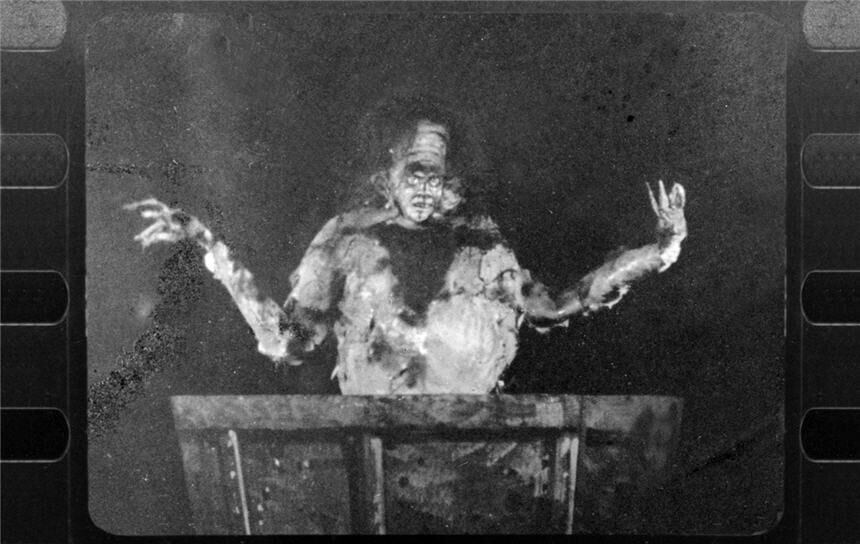Frankenstein
(1910)
When I watched this film for the first time, two main thoughts
went through my head: “This is filmed pretty much like your standard silent
film” and “Wow! The effects are way
beyond the standard silent era film!”
Yes, there’s the typical “stagey” acting and settings and the
motionless camera, but there’s some innovations too. One is the “creation”
sequence, a very unsettling standout. It
nearly churned my stomach and made the hairs on the back of my neck stand
up. (Something modern horror typically
doesn’t do for me.) There’s also
an almost magical element to the monster’s creation, as we see it slowly fuse
together from nothing into a solid human shape (we’ll discuss how these effects
were brought to life on the screen momentarily). And the magical element is
even stronger in the last scenes of the film, where the monster confronts
itself in the mirror and disappears, leaving behind just its reflection for
Frankenstein to see before even that fades away entirely. Evil in the
scientist’s mind created the monster, but love proved so much stronger that the
monster could no longer exist–apparently.
Its secret is a little
obvious if you watch closely: they made a dummy of the monster figure (with a
skeleton inside!), set it on fire, filmed it burning away and then reversed the
footage to make it seem like the creature was slowly generating via unholy
means.
The monster is created not
just through botched science, but it springs forth from the darkness within
Frankenstein himself.
Surviving prints of Frankenstein are pretty
blurry, that being said, we unfortunately cannot see all its creepy detail,
however it still was able to give me “the heebee jeebees”. Even with the haze
of corroded nitrate, this ingenious scene is unique enough to deserve the
status of “classic.”
Film: *****
Effects: ****
Soundtrack:
*** (The link above had the best score!
It significantly was able to enhance the picture without overpowering
the imagery.)
Story: ****
(The story is classic for a reason, the “god-complex” and the realization that
the true monster is the creator and not the creature, is nothing short of
legendary.)
Overall
score: 4 stars! (Highest score
yet!) It is a must view at least once in
one’s lifetime!
The Golem (1920)
This is actually a second Golem film - subtitled “How He
Came Into The World”. (Which you can view the entire 101 minute version here!) The first one being made into a short film in 1914.
This second film returned to the original
story of Rabbi Loew, who creates the Golem to save the ghetto from disaster.
The Rabbi is unable to control his creature, who resembles an incarnation of
some juggernaut-like natural force. The Golem breaks through the ghetto gate
into the world outside, where a pretty little Aryan girl (significantly) offers
him an apple and then plucks the Star Of David from his chest, and he once
again becomes no more than a dead clay statue. Young German maidens dance and
play on the body, which is then ceremoniously carried back into the ghetto by
the Jewish leaders.
The Golem is a richly symbolic narrative drawn from Jewish mythology, but
the question remains after the Golem’s ultimate fate is decided in a startling
instant at the end of the film: Is this a sympathetic portrait of the
oppression Jews faced throughout Europe, in crowded ghettos of twisted lanes
and dark hovels? Or is The Golem more so-called ‘proof’ of Jewish necromancy,
another in a long line of paranoid fantasies about Jews putting spells on
Gentiles (Shylock, Fagin, Svengali, etc.)? For Paul Wegener, the story of The
Golem proved so fascinating that he retold it again and again, rewriting it,
directing it, and playing the creature himself, in a remarkable artistic quest
to understand the tyrannical power of religious myth. The essence of the story
was coincidentally to be repeated in James Whale’s Frankenstein (1931),
but, we will cover that at another article.
This film incorporates sets and imagery that evoke the typical German expressionism that one sees still inspiring modern film makers today. (Hitchcock is an example of a golden age contemporary that utilized some expressionist techniques. More on that in a later article.)
Film: ***
Effects: ***
Soundtrack:
*** (Nothing spectacular, but not distracting.)
Story: **
Overall score: 2.75
Not a great film, but not a bad one either. Surely, a must see for any silent era horror movie aficionado, it contains some great visuals.


No comments:
Post a Comment